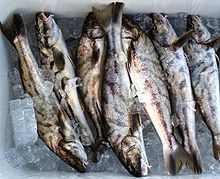Fish preservation

Fish preservation is the method of increasing the
Fish curing includes and of curing
History
Preservation of marine products is of great importance to the coastal poor. Preserved fish products endure adequate protein during low fishing periods. Subsistence fishers use their abundant catch of small fish to make fermented fish paste and smoked fish with the assistance of family members. Large fish are used to make fermented fish or salt dried fish. Other important processing activities include drying of small shrimp, squid, ray and shark and preparation of shrimp paste.[3]
In the past, fishing vessels were restricted in range by the simple consideration that the catch must be returned to port before it spoils and becomes worthless. The development of refrigeration and freezing technologies transformed the commercial fishing industry: fishing vessels could be larger, spending more time away from port and therefore accessing fish stocks at a much greater distance. Refrigeration and freezing also allow the catch to be distributed to markets further inland, reaching customers who previously would have had access only to dried or salted sea fish.
Control of temperature

If the temperature is decreased, the metabolic activity in the fish from
An effective method of preserving the freshness of fish is to chill with ice by distributing ice uniformly around the fish. It is a safe cooling method that keeps the fish moist and in an easily stored form suitable for transport. It has become widely used since the development of mechanical refrigeration, which makes ice easy and cheap to produce. Ice is produced in various shapes; crushed ice and ice flakes, plates, tubes and blocks are commonly used to cool fish.[6] Particularly effective is slurry ice, made from microcrystals of ice formed and suspended within a solution of water and a freezing point depressant, such as common salt.[7]
A more recent development is
-
Fish packed in ice
-
Fish chilling with slurry ice.
-
Fish cooling bypumpable ice
-
Loading blocks of factory-made ice from a truck to an "ice depot" boat
-
Ice manufactured in this ice house is delivered down the Archimedes screw into the ice hold on the boat, Pittenweem
Control of water activity
The
-
Women drying fish in Indonesia, 1971
-
Dry fish market atMohanganj
-
Drying stockfish in Iceland
-
Fish barn with fish drying in the sun –Van Gogh1882.
-
Platforms, called fish flakes, where cod dry in the sun before being packed in salt
-
Remains of Roman fish-salting plant at Neapolis
-
Reconstruction of the Roman fish-salting plant at Neapolis
-
Drying salted fish at Malpe Harbour
-
Salt fish dip at Jakarta
-
Ruins of the Port Eynon Salt House – seawater was boiled to extract salt for preserving fish
Physical control of microbial loads
Heat or ionizing irradiation can be used to kill the
Chemical control of microbial loads
Microbial growth and proliferation can be inhibited by a technique called
Control of the oxygen reduction potential
Spoilage bacteria and
Combined techniques
Two or more of these techniques are often combined. This can improve preservation and reduce unwanted side effects such as the denaturation of nutrients by severe heat treatments. Common combinations are salting/drying, salting/marinating, salting/smoking, drying/smoking, pasteurization/refrigeration and controlled atmosphere/refrigeration.[5] Other process combinations are currently being developed along the multiple hurdle theory.[11]
-
Making fish paste in Cambodia
See:
- Arbroath Smokie(lightly smoked).
- soused(salted).
- cured salmon, and gravlax(fermented).
- Cod: stockfish (air dried), lutefisk (soaked in lye).
See also
- Fish processing
- Dried shrimp
- List of smoked foods
- Sharks fin
References
- ^ M.N., Moorjani (1998). Fish Processing in India. New Delhi: ICAR.
- ^ Charls L., Cutting (2002). Fish Processing and Preservation.
- ISBN 9789264037762.
- ISBN 92-5-103507-5.
- ^ a b c d e f g FAO: Preservation techniques Fisheries and aquaculture department, Rome. Updated 27 May 2005. Retrieved 14 March 2011.
- ^ FAO: Handling of fish and fish products Fisheries and aquaculture department, Rome. Updated 27 May 2005. Retrieved 22 July 2012.
- ISBN 978-2-913149-42-7.
- ^ "Deepchill™ Variable-State Ice in a Poultry Processing Plant in Korea". Archived from the original on February 6, 2012. Retrieved December 4, 2010.
- ^ "Results of Liquid Ice Trails aboard Challenge II" (PDF). April 27, 2003. Archived from the original (PDF) on January 29, 2016. Retrieved December 4, 2010.
- ISBN 978-84-611-9423-0.
- ISBN 978-0-306-47263-3.

















